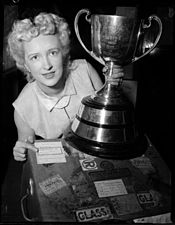Grey Cup
The latest, the 111th Grey Cup, took place in Vancouver, British Columbia, on November 17, 2024, when the Toronto Argonauts defeated the Winnipeg Blue Bombers 41–24.
The Grey Cup is Canada's largest annual sports and television event, regularly drawing a Canadian viewing audience of about 4 million.
The trophy was commissioned in 1909 by The Earl Grey, then Canada's governor general, who originally hoped to donate it for the country's senior amateur hockey championship.
Montreal Gazette writer Bob Dunn claimed that the trophy was later rediscovered as "one of the family heirlooms" of an employee of the Toronto trust company where it had been sent for storage.
[13] Competition for the Grey Cup was limited to member unions of the CRU, the champions of which petitioned the league body for the right to challenge for the national championship.
[17] The same Edmonton team (renamed as Elks for that single season) challenged for the trophy again in 1922, but lost 13–1 to their eastern opposition, the Queen's University Golden Gaels.
[24][25] As the quality of senior football improved, university teams realized they were no longer able to compete on equal footing and withdrew from competition for the Grey Cup in 1933.
[29] Grey Cup play was expected to be suspended along with the unions; however, the military felt the game and sport would serve as a morale booster and organized teams at bases across the country.
[29] A push by the sport's organizers to adopt an increasingly professional attitude dominated the post-war period: poor field conditions, previously accepted as part of the game, resulted in numerous complaints against the CRU following the 1949 and 1950 Grey Cups.
[44] The league also created a new rule during the 1961 Grey Cup as it was the first in history to end regulation time in a tie: CFL Commissioner Sid Halter determined the teams would play an overtime period that consisted of two five-minute halves.
[23] With nine minutes and twenty-nine seconds remaining in the game and Winnipeg holding onto a 28–27 lead, officials made the unprecedented decision to suspend play until the next day.
Both teams fought a see-saw battle, which was decided in the dying seconds of the game when Ottawa quarterback Tom Clements threw to Tony Gabriel, which stood out as the winning touchdown, 23–20.
The 1977 Grey Cup was the first held at Olympic Stadium in Montreal, contested by the home town Alouettes and the Eskimos in front of a record crowd of 68,318.
[51] The game became known as the "Ice Bowl", as low temperatures froze snow on the field that had been melted by groundskeepers with salt, making the artificial turf extremely slippery.
[57] The 1981 Grey Cup was expected to be yet another easy win for Edmonton, who posted a 14–1–1 record during the season and were considered overwhelming favourites against the surprise Eastern champions, the 5–11 Ottawa Rough Riders.
Hoping to restore the league's credibility with fans, a new ownership group featuring Bruce McNall, hockey player Wayne Gretzky and actor John Candy purchased the Toronto Argonauts in 1991 and lured American college standout Rocket Ismail to Canada with a four-year, $26.2 million contract which made him the highest paid player in football history at that time.
[72] The establishment of the National Football League's Baltimore Ravens in 1996 caused the Stallions to seek a new city to avoid direct competition with an NFL team.
[77] The CFL survived into 1997 and was buoyed by an interest-free loan from the NFL,[78] a new television deal with The Sports Network which, along with the launch of its popular Friday Night Football program, has been credited with saving the league.
[51] The CFL restored its reputation over time, enjoying new popularity into the 2000s such that it no longer had to rely on an exciting Grey Cup final to achieve stability for the next season.
[51] In 2009, they defeated the Roughriders in dramatic fashion: placekicker Damon Duval missed a last-second field goal attempt that appeared to give Saskatchewan the victory.
[88] Its original base was made of wood, with silver shields listing each championship year and winning team's name, beginning with the University of Toronto Varsity Blues.
[98] The base stands 84 centimetres (33 in) high and is made of black-lacquered aluminum with silver plates engraved with the names of each winning team's players and executives since 1909.
[100] To accommodate all the plaques within the base of the Grey Cup, they were redesigned using laser etching and a modern typeface that allowed for vertical reduction of the characters and letters that had improved legibility.
Similar to the more famous Stanley Cup used exclusively today by the NHL, members of the winning teams are allowed time to celebrate with the trophy in their own fashion, often taking it to their home towns or tours in locations across Canada.
[105] In recent years, a former football player, a celebrity, or another special guest participates in the coin toss ceremony to recognize their community involvement or significance.
Nicknamed Canada's "Grand National Drunk",[106] the Grey Cup party originated in the 1948 championship when hundreds of Calgary Stampeders fans descended on Toronto for their team's first appearance in the game.
"[108] The Stampeders won the game on the strength of the "sleeper play", a touchdown scored by Norm Hill after he hid himself from the Ottawa defence by lying down on the sidelines, as if asleep.
[110] The boisterous celebrations that followed the win gave rise to the legend of Calgary alderman and future mayor Don Mackay riding his horse into the lobby of the Royal York Hotel.
[51] Five coaches share the record for Grey Cup championships at five: Wally Buono (the CFL's all-time leader in total games won), Don Matthews, Frank Clair, Hugh Campbell and Lew Hayman.
[131] The CFL operated the Canadian Football Network, a coalition of private broadcasters that shared league games and the Grey Cup with the CBC, from 1987 to 1990.






